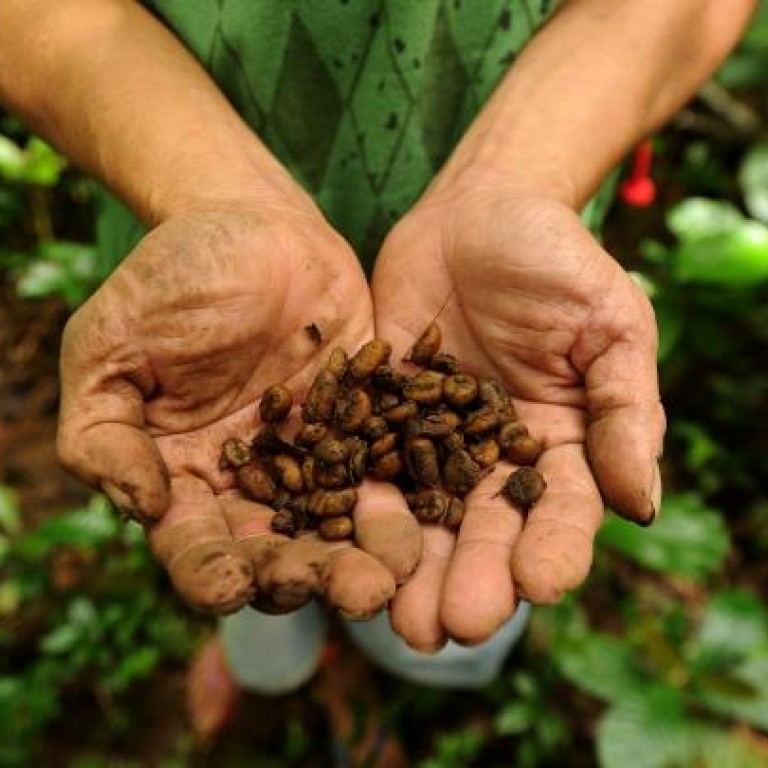
Anyone for civet cat coffee?
Would you spend US$400 on a kilogramme of coffee beans that had been passed through the digestive tract of a civet cat? It’s hard to believe, but those in China who consider themselves coffee gourmets don’t blink twice at this, says Mike Yung, coffee ambassador at Hong Kong coffee specialists Graffeo.
The civet cats of Indonesia apparently love eating coffee beans, which pass through them undigested but the process changes and allegedly enhances the taste of the presumably rather nasty smelling coffee beans when roasted and turned into a drink. Can’t say I fancy it, but each to their own.
The civet cat coffee phenomenon is not new, but it’s taken the mainland Chinese to breathe new life into a fad that had largely been forgotten.
Kopi luwak coffee, as it is called, is pricey, but nothing special, says Yung. “It’s like a rare, expensive, Rolls Royce - is it the best car you car buy? No.”
Graffeo, supplier to hotels, restaurants and serious coffee drinkers, doesn’t stock it, though they will order it as a one-off for existing clients. It’s available in Hong Kong from CitySuper, he thinks, and a small coffee shop near the Galaxy casino in Macau. “I can’t remember the name, but you can recognise it from the queue of mainlanders standing outside,” he says. ”It’s not that expensive, because they only serve seven or eight grammes per cup.” It sounds like the perfect counterfeit product for a gullible audience – who is to say whether the civet cat really ate the coffee bans or not?
So what are real coffee buffs into these days? Hong Kongs’ unsophisticated tastes are changing and growing up. Coffee drinkers are still prepared to fork out HK$30 plus for a shot. Small independent coffee bars are springing up in off the track places in Mongkok, Quarry Bay and Sheung Wan, meeting demand for a lighter-roasted brew. “We’re following the trend of Europe and America for lighter roasted coffee,” explains Yung, who has long been an advocate of this. “When you don’t roast it so dark, you can taste the farmer’s hard work. When you roast it very dark it tastes of nothing, you could be drinking anything.”

Still on the subject of strange things people put in their mouths, France’s super chef Joel Robuchon has moved his Macau restaurant from Robuchon a Galera in the old Hotel Lisboa to Restaurant au Dome and the dizzy heights of the 43rd floor of the Grand Lisboa Hotel. The three-Michelin star eatere is still serving the same high-octane French fare with lashings of foie gras and frogs’ legs and very Gallic service.
But you wonder what Robuchon, an exquisitely dapper and proper French chap, makes of the motley crew of Macau diners, who range from gamblers on a winning streak to dumbed-down teenagers in sneakers, noses glued to their smart phones while moaning that “the wifi is very weak up here” as their mother forks out a fortune for lunch.
But then this restaurant is more gastro theme park than dignified dining venue. There’s the extreme bling chandelier, dangling menacingly from the spectacular domed glass ceiling. The loos are those all-singing all-dancing Japanese ones that heat the seat, then blast your behind with squirts of water and gusts of hot air. It’s a bit like an airline, if you want to check them out, don’t wait til the seat belt sign is about to go on, because there’s guaranteed to be a queue. Everything is larger than life, from the bread trolley crawling with giant dough crustaceans that resemble deep sea monsters, to the vertigo view from the dome out across the bridge to Taipa, with all of Macau spread beneath you.
Among all this drama, Robuchon brings good news. You can now indulge in foie gras guilt-free, he says. The fatty enlarged goose liver is banned in many US states because of cruelty to the force fed geese, but he’s referring to diners’ health. When you eat a HK$560 plateful, you’re doing your ticker a favour, he insists. That’s right; foie gras is the new health food.
"Foie gras is one of the most healthy ingredients, as opposed to what people think, it is an excellent product for those suffering from heart disease - it's very good for the cholesterol," he told me on a recent visit to Macau. When American researchers first reached this conclusion, he too was sceptical, but now, French professors and nutritionists have convinced him. The evidence really shows foie gras to be good for cholesterol and fighting heart diseases. "It is a paradox and I too was surprised, but the proof is there, in southwest France.” Even though it makes you fatter, he concedes. Knew there was a catch.

